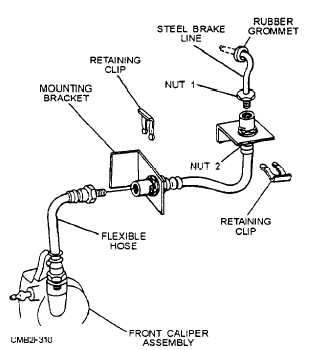
Figure 7-9. - Brake lines and hoses.
Steel lines seldom need replacing except in areas where they rust from exposure to salt air or constant high humidity. Flexible hoses should be inspected at regular maintenance periods for any signs of cracking or abrasion. Should the outer protective covering be cracked or badly abraded, it should be replaced.
Brake Fluid
Brake fluid is a specially blended hydraulic fluid that transfers pressure to the wheel cylinders or calipers. Brake fluid is one of the most important components of a brake system because it ties all of the other components into a functioning unit.
Vehicle manufacturers recommend brake fluid that meets or exceeds SAE (Society of Automotive Engineers) and DOT (Department of Transportation) specifications.
Brake fluid must have the following characteristics:
Low freezing point (not freeze during cold weather)
Water tolerance (absorb moisture that collects in the system)
Lubricate (reduce wear of pistons and cups)
Noncorrosive (not attack metal or rubber brake system components)
Maintain correct viscosity (free flowing at all temperatures)
High boiling point (remains liquid at the highest system operating temperature)
Standard brake fluid (DOT 3) is composed chiefly of equal parts of alcohol and castor oil. This combination of fluids works well under normal conditions but it easily boils and becomes a vapor under heavy-duty applications. Standard fluid also tends to separate when exposed to low temperatures. The increasing requirements of brake fluid led to the development of silicone brake fluid.
After many years of research and development, a brake fluid that was acceptable under extreme operating conditions was developed. This fluid achieved low water pickup and good corrosion protection. The fluid also provides good lubrication qualities and rubber compatibility. Silicone brake fluid has been used in most military vehicles since the end of 1982.
DRUM BRAKES
There are many types of brake system designs in use on modern vehicles. Regardless of the design, all systems require the use of rotating and nonrotating units. Each of these units houses one of the braking surfaces, which, when forced together, produce the friction for braking action. The rotating unit on many motor vehicle wheel brakes consists of a drum that is secured to and driven by the wheel. The nonrotating unit consists of the brake shoes and linkage required to applying the shoes to the drum.
Drum Brake Assemblies
Drum brakes have a large drum that surrounds the brake shoes and hydraulic wheel cylinder. Drum brake assemblies consist of a backing plate, wheel cylinder, brake shoes and linings, retracting springs, hold-down springs, brake drum, and adjusting mechanism.
BACKING PLATE. - The backing plate holds the brake shoes, springs (retracting and hold-down), wheel cylinder, and other associated parts inside the brake drum. It also assists in keeping road dirt and water out of the brakes. The backing plate bolts to the axle housing or spindle.
WHEEL CYLINDER. - The wheel cylinder assembly uses master cylinder pressure to force the brake shoes out against the brake drum. It is normally bolted to the top of the backing plate. The wheel
Continue Reading